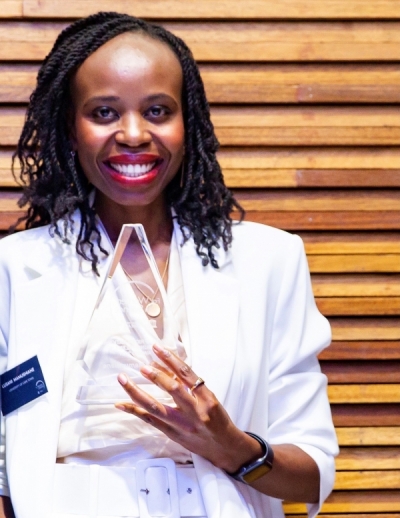L’Oreal UNESCO Award for a PhD electrical engineering student


Lusani Mamushiane, a PhD candidate in the Department of Electrical Engineering, is one of six chosen to participate in the inaugural L’Oréal-UNESCO For Women in Science South African National Young Talents programme. The programme identifies and rewards talented young women scientists in the fields of formal sciences, life sciences, environmental sciences, physical sciences, engineering and technological sciences.
Lusani is based at the CSIR and is supervised at UCT by Dr Joyce Mwangama. Her research topic is on machine-learning assisted network infrastructure sharing to accelerate broadband penetration and to soften entry barriers for ICT SMMEs in developing markets. Lusani’s research interests include but not limited to, network virtualisation, artificial intelligence, blockchain, digital twins, Internet of Things (IoT), and 5G/6G Machine
“My ultimate project goal is to build a prototype that will demonstrate the feasibility of telecommunication infrastructure sharing, to accelerate broadband penetration in South Africa. This will help to bridge the current digital divide that is ever-expanding.”
Ordinary internet is not available to thousands of South Africans, especially in rural areas – this prevents participation in the online world. In the world of the near future, this will go beyond email and Google. It will mean no participation in smart cities, smart farming or smart manufacturing, nor virtual and augmented reality. The gap between those with access and those without, will grow irrevocably large.
Currently, where access is available, it is prohibitively expensive – something which infrastructure sharing will change. The project will quantifiably demonstrate how infrastructure sharing could potentially stimulate competition and save costs for internet service providers which would ultimately lower internet retail prices.
Lusani’s model benefits every tier of the telecommunications chain. Customers will gain improved access, SMMEs will be able to participate in the industry and suppliers will benefit from production cost savings.
It was a personal experience in a rural area of South Africa, which set this scientist on her path to innovation.
“In 2020, I visited Carnarvon with my supervisor Dr. Joyce Mwangama on a Needs Analysis mission at their community health centre and clinic. We went there with a pre-compiled list of 5G use cases (such as telesurgery, connected ambulances and so forth), only to discover that the community did not have the fundamental telecommunication infrastructure to enable any usage. The internet connection at these facilities was extremely limited - and slow - ADSL.”
Hospital staff highlighted challenges, which included a referral system which was still paper-based and inefficient, and difficulty reaching emergency medical services due to bad cell phone reception: a tough call in a community with one, almost-retired, doctor.
An eye-opening drive through the village showed streets filled with children, mid-pandemic, who weren’t learning because they couldn’t access online resources. “I am pursuing this research project because of a painful spotlight on the digital divide in South Africa – and its dire consequences”, she explains.
From a technical perspective, the research aims to demonstrate the feasibility and benefits of integrating machine learning and network slicing to mobile network infrastructures. This will provide a full-fledged architecture design of network slicing with explicit integration points for machine learning (more efficient and accurate than current practice); propose an extended machine learning technique for dynamic network slicing in a shared network infrastructure; build an end-to-end 5G testbed and demonstrate and benchmark the performance of proposed solutions, then carry out techno-economic assessments and provide experience-based recommendations.
The biggest obstacle she has encountered on her research journey (which is still in its very early stages), stems from the limited ICT talent in South Africa. “The talent pool is so small, and my work has so many components that requires me to collaborate with other scientists,” she explains. “This makes it challenging to build completely localised full-fledged solutions that can be commercialised. It also makes it difficult to quickly rollout prototypes as the workload is substantial. I have proactively tried to reach out to potential international research partners and so far, it has helped.
Lusani has this advice for young scientists:
“The desire to contribute to the body of knowledge and to improve social welfare must be strong.
“What is guaranteed, however, is that you will NEVER get bored. The field is constantly evolving and there is so much to learn! Choose a discipline that aligns with your overall goals, read about it, attend career guidance events, ask as many questions about it and then - plunge in!”
As for her own career trajectory, this enterprising young woman maintains refreshing flexibility. Technology is ever evolving, she explains, “… and I will evolve with it!”
Photograph supplied. Article from L"Oreal UNESCO award booklet